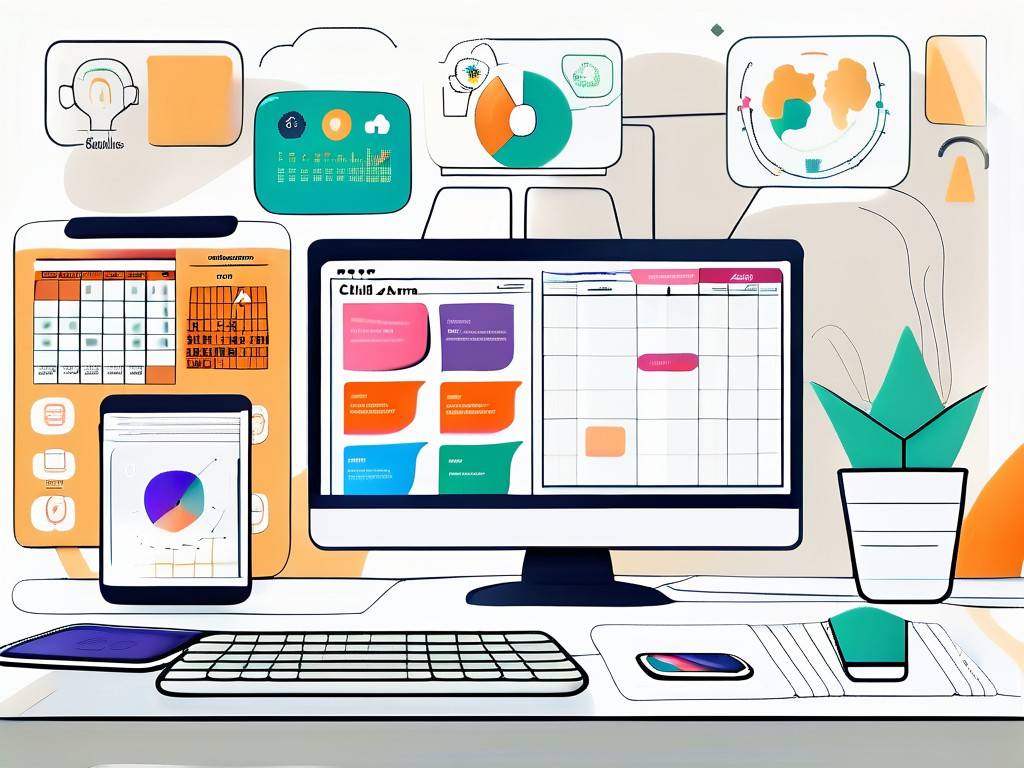Understanding the Challenges of Childcare Administration
Childcare administration is a vital but often overwhelming role within early childhood education settings. Administrators find themselves juggling numerous responsibilities, from managing staff schedules to ensuring compliance with licensing requirements. This multifaceted role demands not only time management skills but also emotional resilience and strategic planning.

One of the primary challenges is balancing administrative tasks with interactions with parents and children. This dual-facing responsibility can lead to an increase in stress levels for childcare administrators who must constantly shift focus from one task to another, making it difficult to maintain productivity. The emotional labor involved in these interactions is significant; administrators often serve as the first point of contact for parents, necessitating a delicate balance of professionalism and empathy. This role requires them to be not only problem-solvers but also active listeners, as they navigate the diverse needs and concerns of families.
The Role of a Childcare Administrator
The childcare administrator is the backbone of any childcare facility. Their responsibilities extend beyond basic administrative tasks; they are also responsible for establishing policies, managing finances, and overseeing staff performance. Additionally, they ensure that the environment is nurturing and safe for children. This includes conducting regular safety audits and ensuring that all staff members are trained in emergency procedures, which is crucial for maintaining a secure atmosphere for young learners.
Effective childcare administrators monitor the growth and development of children in their care. This involves not just supporting educational programming but also being attuned to the emotional needs of children and their families. Therefore, the role requires a deep understanding of child development and family dynamics. They often collaborate with educators to design age-appropriate curricula and may also engage with external specialists, such as child psychologists or speech therapists, to address specific developmental concerns. This holistic approach ensures that every child receives the support they need to thrive.
Schedule a free 30-minutes session with us!
Common Time Constraints in Childcare Administration
Time constraints are a significant obstacle in childcare administration. Reporting requirements, staff training, and parent communication can all quickly consume available hours. Many administrators find that their days are crowded with back-to-back meetings, urgent tasks, and unexpected challenges that interrupt their plans. The constant need to prioritize tasks can create a reactive work environment, where administrators feel they are merely putting out fires rather than proactively managing their responsibilities.
Moreover, the pressure to meet regulatory deadlines adds another layer of urgency, often leaving administrators feeling rushed and inefficient. The cumulative effect of these constraints can lead to burnout if not managed effectively. To combat this, many administrators are now adopting time management techniques such as block scheduling and prioritization frameworks, which allow them to allocate dedicated time for essential tasks while still leaving room for the inevitable surprises that come with the territory. Additionally, fostering a supportive community among staff can help alleviate some of the burdens, as collaboration often leads to shared solutions and reduced individual stress.
Streamlining Communication for Efficiency
One way to combat the time constraints of childcare administration is to streamline communication. Efficient communication methods not only save time but also reduce the likelihood of misunderstandings, which can create additional work. In a bustling childcare environment, where every minute counts, the ability to convey information swiftly and accurately is paramount. This efficiency allows staff to focus more on the children and less on administrative tasks, ultimately enhancing the overall quality of care provided.
Clear communication channels foster a sense of connection among staff and between the facility and parents. Implementing structured communication strategies is key to optimizing how information flows throughout the organization. For example, regular newsletters or updates sent to parents can keep them informed about their child’s progress, upcoming events, and any changes in policies. This not only builds trust but also encourages parental involvement, which is crucial for a child’s development.
Implementing Effective Communication Tools
Utilizing communication tools specifically designed for childcare settings can significantly enhance administrative efficiency. Consider platforms that offer messaging, document sharing, and scheduling features all in one place. For instance, digital calendars and group messaging applications can facilitate quicker decision-making and minimize time spent sending emails. These tools can also include features like reminders for important deadlines or events, ensuring that no detail is overlooked in the busy day-to-day operations of a childcare facility.
Moreover, scheduled staff meetings can be complemented by quick check-ins using communication tools. This flexibility in communication can help resolve issues swiftly and keep everyone aligned with the facility’s goals without lengthy meetings. Additionally, incorporating video conferencing tools can allow for remote participation, accommodating staff who may have scheduling conflicts or those who work part-time. This inclusivity not only promotes teamwork but also ensures that all voices are heard, leading to a more cohesive work environment.
Reducing Miscommunication and Delays
Miscommunication can lead to delays in operations, ultimately affecting the quality of care that children receive. Therefore, it’s essential to establish protocols that minimize uncertainties. Regular updates and feedback sessions can ensure that everyone stays informed and proactive about their roles. Implementing a system for tracking communications can also help identify patterns of miscommunication, allowing for targeted improvements in how information is shared among staff.
Creating an online resource hub where policies and procedures are easily accessible can also prevent confusion and foster a culture of transparency. By leveraging technology, childcare administrators can keep the lines of communication open while saving precious time. This hub could include FAQs, training materials, and a forum for staff to ask questions or share best practices. Such resources not only empower staff but also contribute to a more knowledgeable and confident team, ultimately benefiting the children under their care.
Schedule a free 30-minutes session with us!
Optimizing Administrative Tasks
Time management is critical in childcare administration, making it essential to optimize administrative tasks. This process involves scrutinizing daily activities and identifying areas for improvement so that resources can be allocated more effectively.
By focusing on efficiency, administrators can ensure that their workload is manageable while maintaining high standards of care and education.
Automating Routine Tasks
Automation is a game-changer for busy childcare administrators. Tasks such as attendance tracking, billing, and reporting can be handled with software solutions that reduce manual workload. Automating routine processes not only saves time but also minimizes human error, allowing administrators to focus on higher-priority tasks.
Additionally, consider tools that provide reminders for key tasks, such as renewals or upcoming meetings, so nothing slips through the cracks. By taking advantage of automation, administrators can streamline their operations and create a more efficient work environment.
Prioritizing Tasks for Better Time Management
Effective prioritization is an essential skill for childcare administrators. By identifying which tasks are most crucial, administrators can channel their energy into the areas that will have the most significant impact on their facility.
Strategies such as the Eisenhower Matrix can help categorize tasks based on urgency and importance. This approach allows administrators to delegate less critical tasks effectively, ensuring they can focus on what matters most for the welfare of the children and the operational success of the facility.
Leveraging Technology in Childcare Administration
In today’s digital age, technology is an essential ally for childcare administrators. Leveraging the right tools can significantly enhance operational efficiency and communication, ultimately saving time and resources.

Adapting to technological advancements can yield impressive gains in productivity and organization, making it easier to manage complex administrative responsibilities.
Exploring Useful Software for Childcare Management
A range of software solutions tailored for childcare management can help streamline operations. For instance, platforms that offer family engagement portals enable parents to communicate effectively and access important information about their child’s daily activities.
Moreover, integrated management systems can handle enrollment, scheduling, billing, and reporting, thus freeing up administrators to focus on leadership and quality improvement efforts.
The Impact of Digitalization on Time Management
Digitalization is reshaping how childcare facilities operate, allowing for unprecedented levels of efficiency. By adopting cloud-based solutions, administrators can access information from anywhere, facilitating better decision-making and flexibility.
This transition not only improves time management but also promotes a culture of continuous improvement and modernity within childcare settings. As technology continues to evolve, administrators must be open to adapting and enhancing their practices accordingly.
Building a Supportive Team Environment
A supportive team environment is crucial for improving time management in childcare administration. When staff feel valued and engaged, their productivity and morale enhance, directly impacting the quality of care provided.

Creating a workplace culture that emphasizes collaboration encourages team members to work together effectively, share responsibilities, and ultimately reduce the administrative burden on individual employees.
The Importance of Delegation in Time Management
Delegation is a vital skill that empowers childcare administrators to distribute tasks efficiently. By recognizing the strengths of team members and assigning responsibilities accordingly, administrators can focus on strategic oversight rather than getting lost in daily minutiae.
Moreover, effective delegation fosters professional development within the team, allowing staff to grow their skills and take on more responsibilities, alleviating some of the pressure from administrators.
Fostering a Collaborative Work Culture
Fostering collaboration among staff not only enhances efficiency but also promotes a sense of community. Regular team-building activities and open forums for discussion can help strengthen bonds among staff members and create a supportive environment where ideas and innovations flourish.
Ultimately, a collaborative work culture leads to better communication and shared accountability, which are crucial elements in the successful management of any childcare facility. By investing in team dynamics, childcare administrators can create a more enjoyable and efficient workplace.
